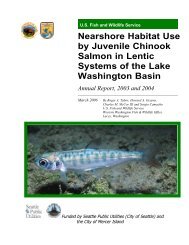2006 Water Comprehensive Plan - City of Bellevue
2006 Water Comprehensive Plan - City of Bellevue
2006 Water Comprehensive Plan - City of Bellevue
- No tags were found...
Create successful ePaper yourself
Turn your PDF publications into a flip-book with our unique Google optimized e-Paper software.
The working capital reserve is maintained to accommodate normal cyclical fluctuationswithin the two month billing cycle and during the budget year. These are higher for<strong>Water</strong> than for Sewer and Storm & Surface <strong>Water</strong> due to more variable revenues andexpenditures. They are described in terms <strong>of</strong> a number <strong>of</strong> days <strong>of</strong> working capital as apercentage <strong>of</strong> a full-year’s budget.The operating contingency reserve protects against adverse financial performance orbudget performance due to variations in revenues or expenses. Again, the <strong>Water</strong> Utilityis most susceptible to year-to-year variations in water demand. They are described interms <strong>of</strong> percentages <strong>of</strong> budgeted wholesale costs and operations and maintenance(O&M) costs.The plant emergency contingency reserve provides protection against a system failureat some reasonable level. The Storm & Surface <strong>Water</strong> Utility requires the largestreserve due to the risk <strong>of</strong> major flood damage to Utility facilities. <strong>Water</strong> and SewerUtilities protect against the cost <strong>of</strong> a major main break or failure. These do not protectagainst the loss <strong>of</strong> facilities that are covered by the <strong>City</strong>'s Self-Insurance to which theUtilities pay annual premiums nor are they sufficient to respond to a major disaster,such as a major earthquake.The reserves <strong>of</strong> the three utilities have historically been treated separately. Thisprotects against cross-subsidy, thereby retaining rate equity for each utility, each <strong>of</strong>which has different customers. However, it results in higher reserve targets, with morefunds retained than otherwise may be needed. Sharing risks among utilities can reducereserves. This does not require that reserves actually be consolidated into a singlefund, but simply that individual reserve targets reflect the strength provided by theavailability <strong>of</strong> cross-utility support. Under the "consolidated" scenario, cash shortfalls inone reserve could be funded through inter-utility loans, to be repaid from future rates.The likelihood that a serious shortfall would occur in more than one fund at the sametime is slight and the benefits <strong>of</strong> lower overall reserve levels will benefit rate payers.Also, the rate policies and the debt coverage policy will ensure that there will be astrong financial response to any significant shortfall. The risk is considered a prudentfinancial policy.For this purpose, O&M costs are the entire annual operating budget <strong>of</strong> the Utility lessthe annual debt service, Capital Investment Program transfers and R&R Accounttransfers. Independent reserve levels are the levels that would be required by anindividual Utility Fund (<strong>Water</strong>, Sewer and Storm & Surface <strong>Water</strong>) at any point in time tocover financial obligations if any one <strong>of</strong> the three reserve components where called for;i.e., working capital, operating contingency or plant emergency. At any single time, thefull independent reserve levels should be available for the individual stated purpose,again because it is unlikely that all three components would be called for at once. Forexample, the <strong>Water</strong> Utility needs $100,000 available for an emergency repair but it isnot likely that the Sewer Utility will need $100,000 and the Storm & Surface <strong>Water</strong> Utilitywill need $500,000 all at the same point in time.The consolidated basis is for budget and rate setting purposes only, to reduce the totalrevenue requirement by considering the reserve risk shared between the three utilities.The dual reserve levels should be considered as circumstances evolve.2-35
















